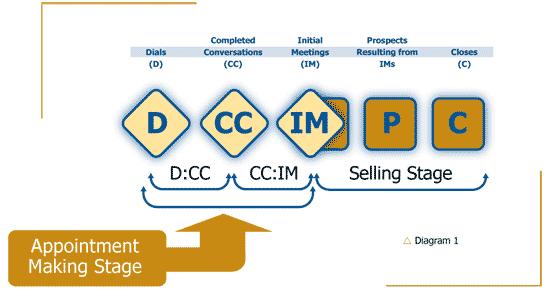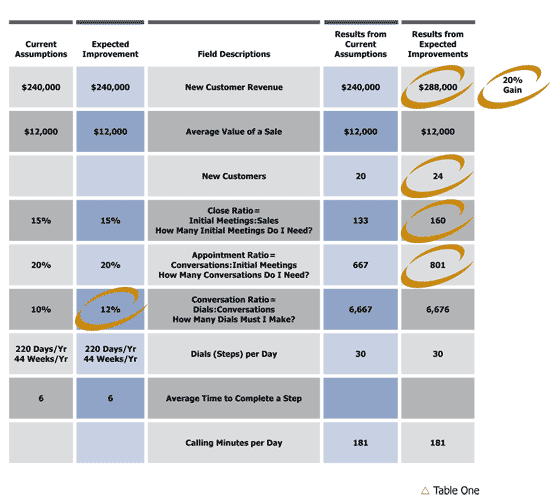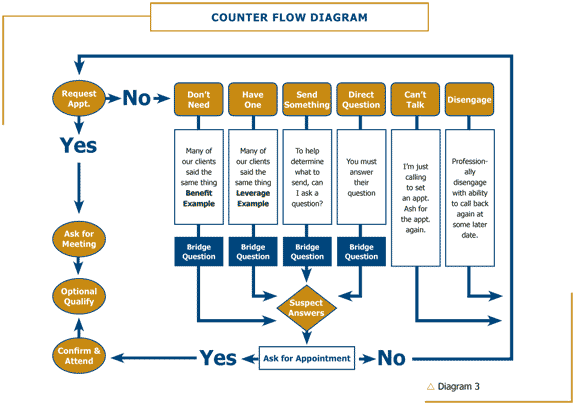The Appointment Making Formula™ Sales
Training

What is
The Appointment Making Formula™?
The
Appointment Making Formula™
(The
Formula, for short)
is our
methodology for the challenge of setting more appointments in today’s
business environment. It is holistic in nature and template
based in application. It is based on years of feedback from
many different approaches to setting appointments to jump-start
activity and sales, whether it is for face-to-face or telesales
selling environments. We believe that the appointment making
process is just another management challenge that can be broken
down into its component parts, monitored, measured and then
incrementally improved from both an effectiveness and efficiency
basis. This is addressed through a combination of ‘Art’, which
is the methodology, messaging and techniques of the process;
‘Science’ or the mechanics of the process; and ‘Best Practices’
which is a combination of both applied uniquely to your
situation.
What makes
The Formula it different?
The difference is our thoughtful approach to a
holistic view of the challenge. Tackling just one piece of the
puzzle will not solve the puzzle. For instance, just attempting
to make your reps (or you) more efficient by installing
automation won’t do it. Being able to make more calls (Science)
when your success ratio is very poor still leads to an
environment of disillusionment at best; and failure and turnover
at worst. Just improving your team’s skills at turning a
conversation into an appointment (Art) won’t do it either.
Having to make fewer calls because of increased effectiveness
certainly helps, but too often enough time to make the calls is
as big an enemy as a lack of effectiveness. In addition, a lack
of automation leads to an ineffective organization. When
turnover in a territory occurs, it is very common to have the
same targets called over and over again and targets that
actually ask to be called later never are. These are the hidden
costs of calling campaigns. And lastly, the definition of a
working and repeatable process (Best Practices) is not
transferred effectively between reps. Each rep is left to
discover the ‘secret to success’ on their own: also a very
expensive process.
The ‘Art’
To address the
effectiveness challenge, most appointment making methodologies
address only the effectiveness (Art) portion of the challenge.
These traditional approaches to the
 techniques
of appointment making, although they once worked, no longer are
as effective
as they once were. That is because, for most of us, the
environment we’re selling into has changed. Traditional
techniques have you concentrate the majority of your effort on
your message and then teach you to handle those first objections
you receive with logic. The problem with that approach is
that it doesn’t work as well as you think it should. That
is because of two operative laws of appointment making that
virtually always apply:
techniques
of appointment making, although they once worked, no longer are
as effective
as they once were. That is because, for most of us, the
environment we’re selling into has changed. Traditional
techniques have you concentrate the majority of your effort on
your message and then teach you to handle those first objections
you receive with logic. The problem with that approach is
that it doesn’t work as well as you think it should. That
is because of two operative laws of appointment making that
virtually always apply:
- The
law of the ‘Status Quo’ – our research indicates that less
than five percent of your universe of suspects is currently in
the market for what you are selling when you call them… so
they don’t think they need you
- The
law of ‘Workus Interruptus’ – no matter when you call, you are
interrupting that person from doing something…so they don’t
want to talk to you
Until you get them beyond the initial ‘knee jerk’
reaction of saying anything (including lying) to get you off the
phone, logic has no place in their thinking.
The Formula teaches how to get the suspect to stop
thinking about how to get you off the phone for a moment, open
their mind to a short conversation, and then use a set of
proven, logical methods and techniques to counter their
responses more effectively.
The
‘Science’
To address the
efficiency challenge we strongly recommend the incorporation of
an automated tool called Klpz to help to help in the process,
and although it is not required for application of The
Formula, its inclusion provides four key advantages:
- It
either allows for the doubling of the number of calls that can
be accomplished in a set period of time or cuts in half the
time necessary to make the same number of calls.
-
Because the tool was designed specifically for the task of
setting appointments, the time and effort involved in using
the tool is so minimal that sales professionals see the value
immediately, take to it quickly, and then actually use it.
- It
automatically provides management (and the sales
professional) with the key metrics to isolate specific areas
for improving performance.
- The
pursuit of each suspect is recorded, providing the sales
professional and the organization with a history of each
pursuit so that the investment of time and energy are not lost
when the inevitable turnover in a territory occurs.
The ‘Best
Practices’
This is the
combination of ‘Art’ and ‘Science’. It is how we define the
most effective way to pursue one individual target effectively,
and in a way that the ‘Best Practice’ becomes a repeatable
process. I believe it was Bank of America that used to run a
commercial stating something to the effect that it processed ten
million checks per day without error by processing one check
perfectly, ten million times. That is the idea of ‘Best
Practices’. Some examples are:
- How
many times will you call a suspect before the law of
diminishing returns kicks in?
- What
should the interval between calls be?
- What
will you do when you give up this time? Will you recycle them,
and if so, what is the number of times you’ll call you them
this year? When will you remove them from your list, and under
what circumstances?
- What
kind of voice-mails will you leave?
- Will
you just call them, mix in e-mail, or use direct mail prior to
beginning your calling sequence?
- What
are the best times to call?
- Where
will you get names to call?
- What
will your value proposition be in your script?
- What
kinds of questions are most effective to get targets to stop
thinking about how to get you off the phone and into a
conversation?
- How
many leads can each rep handle during a year?
- Will
you be asking for a face-to-face meeting, a ‘Webex’ or a phone
call initial meeting?
- Do
you want to qualify during the appointment making call, or do
that during the initial meeting?
- What
does your ‘sweet spot’ suspect look like? Don’t waste your
time on suspects that don’t fit your model or are at the wrong
level.
Why is
The Formula needed?
The Formula
addresses the all important first half of the buying process –
the appointment setting process. (See Diagram No. 1 below.) Why
do we call it all important? There are two reasons.
First, there is no better way
to proactively control your own destiny than to make more
effective appointment making calls. There is a direct
correlation between the number of dials made and the size of
one’s commission check.
Second, it is
the one stage of the buying process that can act as a fulcrum
and dramatically impact the results of rest of the process. In
other words, an increase in the number of initial meetings
provides a larger foundation for more sales, even if you are no
more efficient in the subsequent stages of the buying process.
Some of this advantage is pure math, but some also impact your
business in subtle, yet substantial ways. For instance, how
would your margins increase if you were in a stronger
negotiating position because you had a full sales funnel when
trying to close deals? How would the atmosphere around your
office improve if the discussions changed to those of how to
better qualify the many more prospects you have, creating better
proposals and closing deals instead of the negative vibes that
accompany the ‘we need more activity’ and ‘we can’t afford to
lose this deal’ type discussions you’re probably having now?

What’s the
return on improving the process (ROI)?
There are
three measurable steps in the appointment making process; the
Dial made, the Conversation had and the Appointments set.
Increasing the number of appointments set can only be improved
in three ways: Increasing the number of dials made (usually a
time bound issue), increasing the ratio of Dials to
Conversations (the Conversation Ratio) or increasing the ratio
of Conversations to Appointments (the Appointment Ratio). As an
example of the value of improving the process, we’ll just
examine the impact of improving only the Conversation Ratio. To
do that in The Formula, we could improve the ‘Art’
(voicemails left, finding the right person skills, and handling
gatekeepers, for instance), ‘Science’ (leaving automated emails
and pertinent attachments to dovetail with the voicemails, or
just tracking the results of what works best), and ‘Best
Practices’ which might such things as what are the best times to
call, list procurement measurement, or how many attempts should
be make before the law of diminishing returns kicks in.
In the table
below, if you look in the
Expected
Improvement
column, you’ll see that all we did was move the
Conversation Ratio (Dials: Conversations)
needle 20%
upwards from 10% to 12%. (This ratio, by the way, is now the
toughest to move because so many calls are answered by
voicemail.) If you’ll then look to the Results from
Expected
Improvements
column, you’ll see that this modest increase in the
Conversation Ratio
resulted in the obvious increase in conversations, but also
positively impacted appointments attained, and the most
important result, sales; with a 20% increase if all of the other
ratios stayed the same. (The reason the number of Dials, or
Steps [all of the preparation and recording activity necessary
prior to, and after a Dial] stayed the same was because the time
we dedicated to the task of appointment making remained the same
in this example.)

Strategies
behind The Formula
Until you accept the fact that the person you are calling is
playing by a totally different set of rules than you think they
are (or you think they should be), you will not set near as many
appointments as you will if you accept those rules and play by
them.
Here are the underlying strategies employed in
The Formula to leverage the rules of the game by
which your suspects play:
1. Because
you are interrupting them, be respectful of their time - keep it
short and to the point;
2. Because
you are interrupting them, the purpose of an appointment making
call should be to set an appointment and additionally build just
enough value to make them look forward to the Initial Meeting -
not to sell;
3. Be
professional, yet upbeat and enthusiastic because the majority
of the impact you will make, at least at the beginning of the
call, is from tonality;
4. Even
though only seven percent of effective communication results
from content, and less than five percent of your suspects are in
the market for what you’re selling when you call, it still does
make a difference as to what you say. Once past the ‘Knee Jerk’
reaction stage, you’ll still have to have a good reason for them
to invest time to meet with you.
To accomplish that, you should offer to share
benefit oriented information that is of value to them
in the form of the result of how your solution has
helped others in their position (not, how you think you can help
them – a subtle, but important difference).
5. They
don’t believe they need what you’re selling, and because you are
interrupting them, their first reaction will almost always be to
toss out their favorite Conditioned Knee Jerk Response to get
you off the phone.
By controlling the flow of the conversation,
using a consistent script, and then following the process as
laid out in The Formula, you will be able to
predict the expected Conditioned Knee Jerk Responses you’ll hear
so that you can;
a. Be
prepared to handle them – they’ll be very consistent if you
deliver the same message every time, and if you can predict
those responses you can be prepared to Counter
them effectively and automatically;
b. Act
as if the first Conditioned Knee Jerk Response is not
true because most of the time it is not (if it is, the
techniques of The Formula will still work) – and
use our Counter and Bridge
techniques to refocus the direction of the conversation so you
can;
c.
Use the techniques of The Formula
to get past the Conditioned Knee Jerk Response and start a short
conversation about what they are currently doing and how you’ve
helped others do the same thing, only better. It must be done
in such a way that will turn off the autopilot and get them to
think about your solution from a perspective that will benefit
them and provide you the opportunity to once again:
d.
Ask for the appointment again without hesitation – leave dead
air and they’ll throw up another flavor of Conditioned Response
or a question for you to handle.

Conclusion
We believe
that the small investment made in The Formula more
than pays for itself, and usually within the first buying cycle
after implementation.
You can
read more about the concepts behind The Formula
and return on investment calculations in our two ground breaking
White Papers:
Is Cold Calling Really Dead? Searching for the
Elusive ‘Silver Bullet’ and
The Appointment Making Formula™
Four Steps to More Effective Appointment Setting.
For a more thorough description of the Face-to-Face 1 1/2 day
workshop,
click here...
For a more thorough description of the Web-based workshop,
click here...
For more information on
the details of the Art, Science, and Best Practices, please
visit our sister website
ColdCalling101.com.
